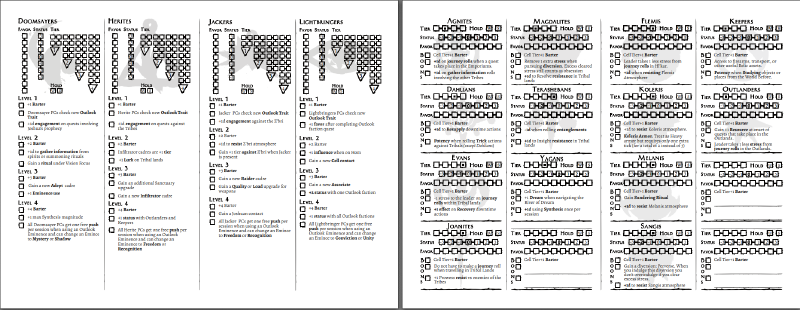The Silhouette edition of the Tribe 8 TTRPG was brimming with factions, each vying for control or dominance in and around Vimary. Bringing the setting to Forged in the Dark meant an opportunity to engage the faction game and craft some unique mechanics around it.
Anyone who’s read Blades in the Dark will recognize a few things about the factions, such as Tier, Hold, and Status. But there’s also Favor and Boons. Favor is similar to Reputation, except it’s tracked for each faction independently instead of being on the Cell. Boons are bonuses or other advantages the Cell can choose from. Most boons are unique to that faction and not attainable by the Cell from any other faction.
Too Many Damn Factions
The number of factions in Tribe 8 puts the faction list in Blades in the Dark to shame. We knew we wanted to concentrate on the major ones—the Fallen Outlooks, the Tribes, the Z’bri Houses, the Keepers, the Outlanders. That still gives over a dozen factions to work with and is plenty for most Weavers to keep track of. Even so, it’s easy to add subfactions or entirely new factions to the game. There’s a short section about doing just that in the rule book, and several groups are mentioned in the sections for various factions that are great candidates for focusing on. Of course, you can always add whatever factions you’d like from the original Tribe 8 books.
Fallen Focused
Just as the playbooks focus on the Fallen, we wanted the faction mechanics to firmly center on the four Fallen Outlooks as factions. To give them that spotlight, we made their advancement more in-depth. Where the other factions advance when the Weaver feels appropriate, the Fallen Outlooks have advancement tracks for each Tier. These tracks are filled as the PCs perform quests for the faction. In return, not only does the Cell increase in Tier as the lowest Tier faction advances, but the Outlooks have more boons available than the other factions. This parallels crew XP and claims in other FitD games to a degree, but everything is on the faction side. Moreover, unlike most FitD games the relationship between the PCs and the Fallen Outlooks is cooperative and not competitive. The goal isn’t to rise up above the Outlooks, but to raise them up and, along with them, the PC Cell.
The Other Factions
As mentioned earlier, the other factions don’t have advancement trackers. They also have only three boons each to choose from. The intent is for a Cell to perform some quests for these non-Outlook factions—possibly even unintentionally—but it will be secondary to performing quests for the Outlooks. As these other factions’ goals come to fruition, they introduce exciting choices for the PCs and the possibility of conflict. Do they accept a quest from this faction in the hope of getting enough favor for a boon? Do they ignore the faction and potentially lose favor? What if they were manipulated into achieving a faction’s goals?
We’ve found from playtesting that these new faction mechanics add another layer to Tribes in the Dark. The interplay between the Outlook Factions and the Cell adds new depth thanks to using FitD that aren’t present in the original Tribe 8. Hopefully, once this latest edition is out there and in your hands, you’ll have the same experience.
